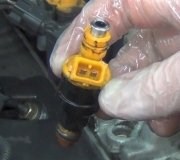Another problem I've been told about numerous times is mismatched injectors but this is always related to GM vehicles. As the story goes, GM doesn't flow-match their injectors on the assembly line. They just grab a handful from the bin and stuff them in. When you reach high mileage, an injector that flows less than the others will make that cylinder lean. The oxygen sensor detects the unburned oxygen in the exhaust and the Engine Computer interprets that as all cylinders are lean. In response, it adds more fuel to all of the cylinders, but no matter how much extra fuel it keeps adding, there will still be that unburned oxygen. You may smell the extra fuel at the tail pipe, but the oxygen sensor still tells the computer the mixture is too lean, hence the drop in fuel mileage. That's why I was asking about the symptom.
This story came from Jim Linder of Indianapolis. He puts on very expensive classes all over the country talking about fuel injection systems and problems. He owns one of the few companies in the nation that rebuild injectors, then they sell them in flow-matched sets. Many of his customers comment that their GM engines never ran so smoothly even when they were new.
There's a few other things to consider. First of all, how many people remember how their engine ran 100,000 miles ago? Second, those engines must have run fine when they were new or people wouldn't have bought those cars. He also said the biggest percentage of their sales were for GM injectors, but there's more GM cars on the road too.
Chrysler buys their injectors from Bosch in flow-matched sets and problems are extremely rare. You don't hear much about other manufacturers having injector trouble. I have to wonder if all injectors suffer from the same deposits but GM's are more susceptible to the results of those deposits. The next question is if rebuilt injectors were really needed in most cases or if cleaning would have restored the flow rates enough to solve any problems. Naturally when you get rebuilt injectors they're going to be perfectly clean. So what solved the problem, the clean of the new injectors or the matched flow rates?
I doubt GM would issue a service bulletin that blames a running problem on mismatched flow rates but if cleaning gets them back to working better, you can't argue with success. Obviously people are having some good results with the cleaning machines and the canisters of "soap" that the engine will run on for 20 minutes that saturntech9 is referring to, otherwise no one would be buying the products or selling the service to their customers. Try the products saturntech9 referred to first, particularly if the drop in fuel mileage was gradual and over a long period of time. If the drop was sudden, you might look for a cracked or dry-rotted vacuum hose or some other vacuum leak. That will also introduce extra oxygen in the exhaust leading to more fuel being commanded by the Engine Computer.
Thursday, April 12th, 2012 AT 5:40 AM




